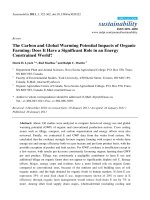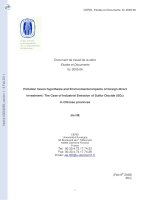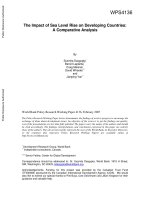Vietnam coastal cities and potential impacts of sea level rise pps
Bạn đang xem bản rút gọn của tài liệu. Xem và tải ngay bản đầy đủ của tài liệu tại đây (20.22 KB, 5 trang )
Vietnam coastal cities and
potential impacts of sea level rise
Dr. Pham Si Liem
Institute for Urban Studies & Infrastructure Development.Hanoi-Vietnam
Email:
ABSTRACT: More than twenty Vietnam coastal cities with a population of ten million are
directly subjected to the impacts of a rising sea level. As this is a very slow-onset event, the risk
perception of the society is weak. In this context, the paper explores a range of issues related to
disaster vulnerability and identifies priorities for disaster prevention and preparedness for living
with risk.
KEY WORDS: Sea level rise, Urban vulnerability, Adaptation policy, Information gathering and
exchange
Introduction
Sea level rise is a complex phenomenon
related to the global climate change.
Although the mean increases in sea level
All abovementioned major impacts of
sea level rise once occurred will
engender huge negative effects to the
development of Vietnam in the future.
rise associated with the Intergovernmental
Panel on Climate’s Change (IPCC) non
mitigation scenarios are modest-ranging
from 0.2 to 0.5 meters during this century,
future sea level rise
is not expected to be
globally uniform. Some regions, including
South-East Asia, show a sea level rise
substantially more than the global
average.
This paper focuses on the potential
impacts of sea level rise on Vietnam
coastal cities and explores the concept of
a desirable urban adaptation policy
required to cope with this profound and
durable disaster.
Vietnam cities facing sea level rise
By 2007, 27.4 per cent (23.4 million)of
the Vietnam’s population lived in urban
areas, and of this urban population almost
75% lived in coastal and delta zones.
Vietnam has long coast ( 3260km) and a
dense river network, including the Red
River and the Mekong River that originate
in catchements in other countries and
create large river deltas (17,000km2 and
59,000km2, respectively), characterized
by an accerelated urbanization.
Climate change concerns Vietnam deeply.
The recent study of Dasgupta and others
In difference from others short-term
natural disasters, sea level rise is a very
slow-onset and irreversible event that
demands long-term response such as
coastal cities relocation to higher land,
protection of coastal and near coastal
low-lying urban areas by increasing the
robustness of infrastructural designs
and systematic investments in seawalls
and dykes, improving water supply,
drainage and sanitation. The impacts of
sea level rise on rural areas will
generate an additional migration of
people to cities, therefore an efficient
demographic management will be
needed. Briefly, given that the
forthcoming sea level rise could
massively impact the society and be
truly national in scope, there is a need
to formulate an overall proactive
adaptation policy as suggested by the
United Nations Framework Convention
on Climate Change (UNFCCC).
Preliminary considerations for
Vietnam adaptation policy
The effects of sea level rise vary
greatly among countries, even for
countries in a same region, therefore
adaptation efforts must be tailored to
specific needs of Vietnam. However,
ranks Vietnam among the top five
countries most affected by one meter rise
in sea level with 10.79% of population,
10.21% of GDP,10.74% of urban areas
and 28.67% of wetlands affected.Many of
the largest cities of Vietnam such as
Hochiminh City, Haiphong, Hue, Danang,
Nhatrang, Vungtau are directly subjected
to the impacts of sea level rise.
Vietnam ratified the Kyoto Protocol since
1999. A Climate Change Office has been
set up within the Ministry of Natural
Resource and Environment (MONRE).
Recently, the Science, Technology and
Environment Committee of the
Parliament examines at first time the
impacts of climate change on the national
development sustainability. MONRE
actually is preparing a national targeted
program to cope with climate change and
sea level rise for the period 2009-2015.
Impacts of sea level rise on Vietnam
urban areas
Costal and near - coastal low-
lying urban
areas are particularly vulnerable to sea
level rise related hazards, including:
- Total submersion
adaptation policy has to focus on
general principles rather than specific
details. Given the strong
decentralization in Vietnam, each
coastal provincial government has the
capacity to develop and to adopt its
appropriate region-specific coping
programs.
As the sea level rise is a long-lasting
process, and there are some
uncertainties regarding IPCC results,
the adaptation policy must be thought
of as an ongoing learning by doing
participatory process, including
planning, implementation, monitoring
and adjustment.
Nobel laureate Tom Schelling has
argued that the best way for developing
countries to adapt to climate change is
to develop. Thus, Vietnam disaster
adaptation planning should be part of
national development planning and
should be discussed at local and
national levels, and urban hazard
mitigation needs to be seen as one goal
within integrated coastal zone
management.
For Vietnam, sea level rise risk is a
serious risk. Therefore, this source of
risk should be sufficiently accounted
for in cost-benefit analysis (CBA) in
- Flooding
- Erosion
- Salinization of ground and surface water
Total submersion will be likely the
destiny of the Camau peninsula, that will
cause a land loss of 8000km2 and the
resettlement of a population exceeding 1.5
million inhabitants.
By virtue of being located at riversides
and low lying plains, especially at the
Mekong Delta, many cities have been
subjected to periodic flooding since its
early days. At coastal areas flooding can
occur for a range of sometimes interacting
reasons,including storm surges induced
by typhoons, land subsidence due to
excessive ground water withdrawal
(Hanoi), high tide (Haiphong, Hochiminh
City), intense local precipitation in areas
with poor drainage, sedimentation of river
estuaries. Associated with the rising sea
level, flooding will become catastrophic
and cause dramatic damage to urban
areas.
Variations in river and coastal flow, storm
surges and sea level can cause significant
erosion of river banks and sea beaches
leading to land loss, relocation of urban
quarters and degradation of beach
development planning and in appraisals
of infrastructure investment and risk
management projects. Then, properly
developed specific CBA associated
with political, economical, social and
technological (PEST) analysis should
be integral elements of decisionmaking
and may contribute to improve the
allocation of scarce resources to the
most profitable and least risky
undertakings.
Raising societal perception and
preparedness to sea level rise is needed
but should be undertaken carefully step
by step in view to avoid scattering
panic among the public.
As sea level rise is global, there is a
need for regional and international
cooperation in forecasting, information
gathering and exchange. In this regard,
are involved not only United Nations,
World Bank and others
intergovernmental organizations. For
the same purpose many institutions of
civil society such as NGOs and CBOs
can provide a bridge between
researchers and stakeholders of
different countries.
Conclusion
resources that are used for tourism.
The sea level rise also causes salt water
penetration far upstream in dry season,
especially during droughts, and
salinization of coastal ground water. This
event will endanger water supply of all
coastal cities, including Hochiminh City
and Hanoi.
Sea level rise poses a great threat to
Vietnam coastal cities and will affect
the country macroeconomy. The
disaster adaptation policy should be
considered as a continuing learning in
doing process. The best way for
Vietnam to cope with sea level rise is
to develop with the support of
international response organizations
into a developed country in the near
future.
References
The World Bank.2003. Building Safer
Cities. The Future of Disaster Risk.
The World Bank.2008. Global
Monitoring Report. MDGs and the
Environment. Agenda for Inclusive
and Sustainable Development.









